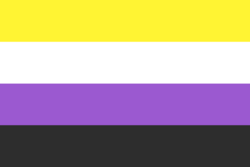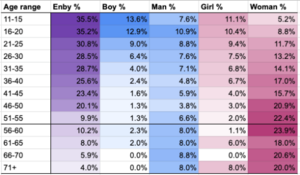Non-binaire
| ||||||
 Meaning -Yellow: gender without reference to the binary. -White: many or all genders. -Purple: gender between or a mix of female and male. -Black: lack of gender. | |
| Related identities | transgender, genderqueer |
|---|---|
| Click here to see alternative flags! | |
La non-binarité (en anglais non-binary) est un terme générique comprenant toute gender identity (identité du genre) ou expression (expression du genre) n’étant pas comprise dans la gender binary (norme binaire). Cette étiquette peut aussi être utilisée par des individus souhaitant s’identifier comme ne faisant pas partie de la norme binaire sans pour autant préciser leur genre.
Étant un terme générique, la non-binarité a une dimension similaire au genderqueer la plupart des personnes non-binaires d’Inde tiraient également à l’identité genderqueer. Cependant ces deux termes ont des significations et des connotations bien différentes. Le terme genderqueer précède le terme non-binaire depuis plus d’une décennie.
Kye Roman crée le drapeau non-binaire (montré à droite) en 2014. Ce drapeau est fait pour « représenter la communauté non-binaire qui ne se sentaient pas représentés par le genderqueer flag (drapeau genderqueer). Le drapeau avait pour but d’être complémentaire au drapeau genderqueer créé par Marilyn Roxie, plutôt que de le remplacer. Le drapeau est constitué de quatre bandes. Du haut vers le bas, elles sont jaune, blanc, violet et noir. Le jaune représente ceux dont le genre se situe sans référence et en dehors de la binarité, car le jaune est souvent utilisé pour distinguer une chose à part entière. Le blanc représente ceux qui ont beaucoup ou tous les genres, car le blanc est la présence photologique de la couleur et/ou de la lumière. La bande violette représente ceux qui identifient leur genre comme entre homme ou femme ou un mélange des deux, le violet étant le mélange des couleurs traditionnellement associées aux filles et aux garçons. Le violet peut aussi être perçu comme la représentation de la fluidité et de l’originalité des personnes non-binaire. Enfin, la bande noire représente ceux qui s’indentifient comme n’ayant pas de genre, le noir étant l’absence photologique de couleur et/ ou de lumière. » Le drapeau non-binaire ainsi que le drapeau genderqueer sont deux options permettant aux personnes non-binaires de se représenter et prendre différentes approches sur la façon de représenter les personnes non-binaires.
Histoire
Voir l’article principal : history of nonbinary gender
Kye Roman crée le drapeau non-binaire (montré à droite) en 2014. Ce drapeau est fait pour « représenter la communauté non-binaire qui ne se sentaient pas représentés par le genderqueer flag (drapeau genderqueer). Le drapeau avait pour but d’être complémentaire au drapeau genderqueer créé par Marilyn Roxie, plutôt que de le remplacer. Le drapeau est constitué de quatre bandes. Du haut vers le bas, elles sont jaune, blanc, violet et noir. Le jaune représente ceux dont le genre se situe sans référence et en dehors de la binarité, car le jaune est souvent utilisé pour distinguer une chose à part entière. Le blanc représente ceux qui ont beaucoup ou tous les genres, car le blanc est la présence photologique de la couleur et/ou de la lumière. La bande violette représente ceux qui identifient leur genre comme entre homme ou femme ou un mélange des deux, le violet étant le mélange des couleurs traditionnellement associées aux filles et aux garçons. Le violet peut aussi être perçu comme la représentation de la fluidité et de l’originalité des personnes non-binaire. Enfin, la bande noire représente ceux qui s’indentifient comme n’ayant pas de genre, le noir étant l’absence photologique de couleur et/ ou de lumière. » Le drapeau non-binaire ainsi que le drapeau genderqueer sont deux options permettant aux personnes non-binaires de se représenter et prendre différentes approches sur la façon de représenter les personnes non-binaires.
In 2014, "Nonbinary" was one of the 56 genders made available on Facebook.[2]
Usage of the term enby

The word enby (plural enbies, from N-B) is an alternative word that can be used to talk about nonbinary people. It seems to have been coined by Tumblr user revolutionator in 2013 as the nonbinary equivalent of boy and girl.[4][5] As such, many people don't understand it as a full equivalent for nonbinary and instead it's often used to refer to nonbinary people of young age. The 2020 Gender Census shows how the older someone is, the less likely they are to use this word for themselves.[3]
Nonbinary identities
There is more information about this topic here: List_of_nonbinary_identities
Some of the more common identities that fall under the nonbinary umbrella include, but are not limited to:
- Agender aka Genderless, Non-gender - Having no gender identity or no gender to express (Similar and sometimes used interchangeably with Gender Neutral and/or Neutrois).
- Androgyne aka Androgynous gender - Identifying or presenting between the binary options of man and woman or masculine and feminine (Similar and sometimes used interchangeably with Intergender).
- Multigender (may also include Androgyne) - Moving between two or more different gender identities at different times/situations or having more than one gender identity at one time. Some multigender identities are bigender, polygender, and genderfluid.
- Gender Neutral aka Neutral Gender - Having a neutral gender identity and/or expression, or identifying with the preference for gender neutral language and pronouns.
- Genderqueer aka Gender Queer - Non-normative gender identity or expression. While genderqueer originated as an inclusive umbrella term, it is also considered by many to be an individual identity.
- Intergender - Having a gender identity between the two binary options of man and woman or masculine and feminine
- Neutrois - Belonging to a non-gendered or neutral gendered class, usually but not always used to indicate the desire to hide or remove gender cues
- Nonbinary or non-binary - Identifying with the umbrella term covering all people with gender outside of the binary, without defining oneself more specifically. Is also used as an individual identity in itself. One could be nonbinary butch or nonbinary femme.
- Transgender - Identifying with the umbrella term covering all gender identities or expressions that transgress or transcend (go beyond the limits of) society’s rules and concepts of gender (Transgender is a wide umbrella term also covering people who hold binary gender identities and expressions but who transgress gender by transitioning between the binary genders).
You can read about many more of these at list of nonbinary identities.
Nonbinary presentation and expression
There is no single or 'correct' way to perform a nonbinary gender. Most nonbinary people are primarily motivated by the desire to be comfortable and true to themselves rather than attempting to follow any particular gender role. Nonbinary people may or may not experience gender dysphoria or may experience only bodily or social dysphoria. Nonbinary is a wide umbrella term covering a large number of gender identities and expressions. Whichever way any particular nonbinary person needs or chooses to present, express or perform their gender is as valid as any other.
Not all nonbinary people experience gender dysphoria or follow the 'transition' narrative. Some feel that there is no social role or body to 'transition' to and so simply focus on being themselves.
Androgynous or gender neutral presentation
Some nonbinary people may choose or need to present an androgynous or gender neutral gender expression; perhaps choosing to hide, remove or blend gender cues. This is personal to each individual and is not any more nonbinary than any other way of expressing a nonbinary gender.
Some nonbinary people experience bodily dysphoria relating to certain primary or secondary sexual characteristics. The act of obscuring, removing or replacing these sexual characteristics in order to reduce gender dysphoria may result in physical androgyny without the individual having set out to specifically obtain an androgynous presentation.
Genderfuck
Some nonbinary people may choose or need to present a 'clashing' combination of gender cues that are incongruous, challenging or shocking to those who expect others to fit the gender binary. For example, combining a beard with makeup and a padded bra. This practice of transgressively breaking the rules of gender presentation is known as genderfuck, genderfucking or sometimes genderpunk.
Gender neutral language
Some nonbinary people prefer to be referred to using gender neutral language and pronouns. Some choose a gender neutral title such as Mx or Misc for formal communications. Others may opt for no title.
Expanding or subverting binary gender roles and language
Some nonbinary people prefer to expand on or subvert what is considered socially acceptable for their assigned gender. This may involve preferring binary pronouns while crossdressing, blending or mixing gender cues or otherwise subverting the expectations society places on that gender role. Some may consider this to be a political act, for others this is simply an expression of self identity or personality. Some nonbinary people have no preference for gender neutral language but instead have a preference against the language and pronouns associated with the gender they were assigned at birth.
Notable nonbinary people
See main article: Notable nonbinary people
There are many more notable people who have a gender identity outside of the binary. The following are only some of those notable people who specifically use the word "nonbinary" for themselves.
- Olly Alexander, the lead singer and songwriter for electropop band Years and Years.[6]
- Kate Bornstein, an influential writer on gender theory, publishing books on the subject from the 1990s to the present.[7]
- Amanda Stenberg, a singer and actor who has won the BET Awards for YoungStar Award.[8][9]
- Rebecca Sugar (a nonbinary woman) is a writer, songwriter, and artist whose work on the cartoon series Adventure Time and Steven Universe has earned her six Primetime Emmy Award nominations.[10]
- Sam Smith, a renowned English singer, Grammy winner and nominee. They came out as non-binary and changed their pronouns to they/them in September of 2019. [11]
Personnages non-binaires dans la fiction
Voir l’article principal: Nonbinary gender in fiction
Il y a beaucoup plus de nonbinary characters in fiction who have a gender identity outside of the binary (personnages non-binaires qui ont une identité du genre en dehors du binaire. Les personnages suivants sont quelques-uns d’entre eux qui sont désignés par le terme « non-binaire » que ce soit par eux-mêmes, ou par leurs créateurs.
Veuillez s’il vous plaît étendre cette section, en donnant des citations qui montrent que les personnages sont spécifiquement désignés par le mot « non-binaire »
Voir aussi
- Gender-variant identities worldwide
- Gender designation in different cultures
- Gender neutral language
- Glossary of English gender and sex terminology
Références
- ↑ This quote is a snippet from an answer to the survey conducted in the year 2018. Note for editors: the text of the quote, as well as the name, age and gender identity of its author shouldn't be changed.
- ↑ Eve Shapiro, Gender circuits: Bodies and identities in a technological age. Unpaged.
- ↑ 3.0 3.1 Cassolotl (15 June 2020). "On "enby" and age". Gender Census. Retrieved 15 June 2020.
- ↑ @cassolotl on Tumblr (September 2013)
- ↑ argentconflagration on Tumblr (November 2013)
- ↑ Years & Years: Inspiring - #PlessPlayForPride Spotify, June 7 2016
- ↑ Retrieved November 11, 2019. http://katebornstein.com
- ↑ hi folks, @dazedfields and I are organizing a workshop on feminism, amandla.tumblr.com, March 2, 2016
- ↑ Hunger Games actress says she 'doesn't feel like a woman all the time', Gay Star News, March 4, 2016
- ↑ https://io9.gizmodo.com/steven-universes-rebecca-sugar-on-how-she-expresses-her-1827624015?IR=T
- ↑ https://www.bbc.com/news/entertainment-arts-49688123

